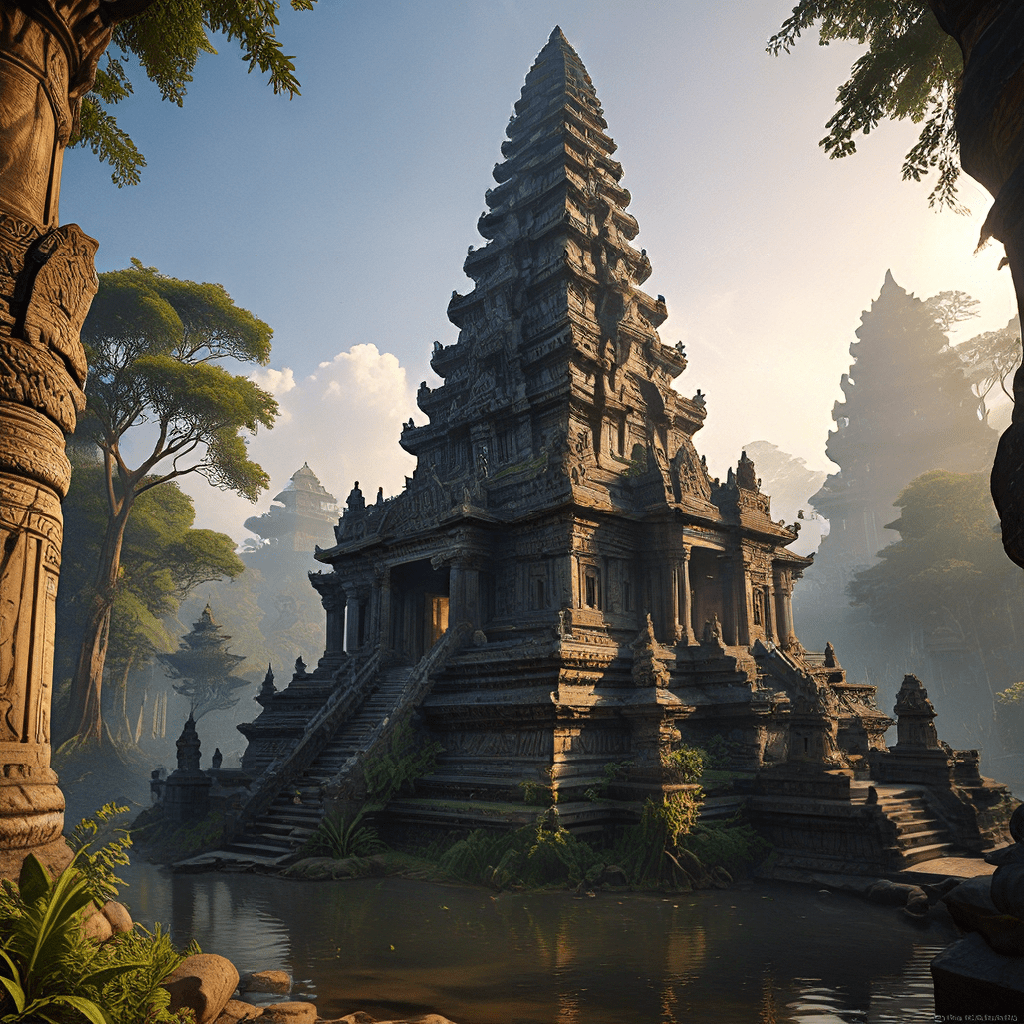Indonesian Temples: Unveiling Ancient Myths
1. The Divine Mandate: The Role of Gods and Spirits in Indonesian Mythology
Indonesia, a vast archipelago of over 17,000 islands, is a tapestry of diverse cultures and rich mythology. At the heart of this rich tapestry lies a belief in the divine, where gods, spirits, and mythical beings play a crucial role in shaping the world and the lives of those who inhabit it. These beliefs often center around the concept of a cosmic order, a balance between the spiritual and physical realms, represented in the natural world and influenced by the actions of human beings.
Spirits, often associated with nature, inhabit the forests, mountains, rivers, and seas, representing the unseen forces that govern the world. These spirits are believed to be powerful and influential, capable of influencing human fortunes, causing illness, or bringing prosperity.
The pantheon of gods, often inspired by Hindu and Buddhist beliefs, are seen as divine entities who oversee specific aspects of life, such as creation, preservation, and destruction. The stories and myths surrounding these gods provide a framework for understanding the world, explaining natural phenomena, and offering guidance on how to live a fulfilling and righteous life.
2. A Tapestry of Beliefs: Exploring the Diverse Mythologies Across Indonesia
The island nation of Indonesia is home to a vast array of unique and vibrant mythologies, each reflecting the unique history and traditions of its people. These differing beliefs are not merely isolated tales but provide insights into the cultural values, beliefs, and worldviews that shape the lives of Indonesians.
In Java, for instance, the myth of the "Sang Hyang Guru" or "Supreme Teacher" embodies the spiritual and moral principles of Javanese society. This deity is often associated with the creation of the world and the establishment of social order.
On the island of Bali, the intricate mythology revolves around the concept of "Tri Hita Karana," meaning "three sources of well-being," which emphasizes harmony between humans, nature, and the divine. The Balinese believe in a complex hierarchy of gods and spirits, each presiding over specific aspects of life.
In Kalimantan, the indigenous Dayak tribes have a rich mythology filled with tales of ancestral spirits, mythical creatures, and intricate rituals. Their beliefs emphasize the interconnectedness of humanity with nature, emphasizing respect for the forests and the importance of maintaining balance in the ecosystem.
3. The Temple as Cosmic Axis: Connecting the Spiritual and Physical Realms
Throughout Indonesian history, temples have served as more than mere places of worship. They are considered sacred spaces, serving as a powerful connection between the spiritual realm and the physical world, acting as a conduit for communication with the divine.
These temples are often built in strategic locations, atop mountains, overlooking valleys, or at the confluence of rivers, symbolizing the intersection of nature and the divine. Their architecture and design are carefully planned, reflecting the belief that the temple structure itself emulates the cosmic order, aligning with the flow of energy and connecting the heavens, earth, and underworld.
The temple architecture, often adorned with intricate carvings and symbolic motifs, serves as a visual representation of the overarching mythology, offering a tangible reminder of the interconnectedness of the physical and spiritual realms.
4. Architectural Echoes of Mythology: Symbolic Motifs and Their Meanings
The architectural design of Indonesian temples is not merely aesthetic but serves as a tangible expression of the underlying mythology. Each element, from the shape of the roof to the intricate carvings, holds symbolic meaning, echoing the stories, beliefs, and values of the people.
For instance, the tiered roofs of many temples are reminiscent of Mount Meru, the mythical cosmic mountain that serves as the center of the universe in Hindu and Buddhist mythology. This architectural feature signifies the temple's role as a gateway to the divine, a place where the earthly realm aligns with the celestial.
Intricate carvings depicting scenes from mythology, tales of gods and spirits, and stories of heroes and epic battles adorn the walls and pillars. These carvings serve as visual narratives, reminding people of their beliefs and cultural heritage.
The statues and sculptures inside the temple are often representations of deities, mythical beings, or revered ancestors, each embodying specific divine qualities and powers. The positioning and orientation of these statues within the temple are carefully considered, reflecting the cosmic order and the relationships between the different gods and spirits.
5. The Power of Ritual: Temples as Centers of Worship and Sacrifice
Temples serve as the focal point for religious rituals and ceremonies, offering a platform for expressing devotion, seeking guidance, and seeking divine intervention. Rituals, often involving offerings and sacrifices, are performed to appease the gods, seek blessings, or commemorate significant events.
These rituals, often passed down through generations, are carefully choreographed, involving specific gestures, chants, and offerings. Each element of the ritual holds a specific meaning, representing the relationship between humans and the divine, and ensuring the continuation of the cosmic order.
The offerings, often consisting of food, flowers, and incense, are symbolic gestures of respect and gratitude. Sacrifices, while not as common in modern times, were once considered a necessary act to appease the gods and ensure their favor. The act of sacrifice, whether animal or symbolic, represents a willingness to give up something precious in exchange for divine favor.
6. The Borobudur: A Buddhist Mandala Representing the Journey to Enlightenment
The Borobudur, located in central Java, is one of the most remarkable Buddhist monuments in the world. This massive temple complex, built in the 8th and 9th centuries, is a breathtaking example of Buddhist art and architecture. The Borobudur's unique structure, shaped like a giant mandala, symbolizes the journey to enlightenment and the interconnectedness of all things.
The temple is composed of six square platforms, three circular platforms, and a central dome, representing the different stages of spiritual development. These platforms are adorned with over 2,672 relief panels and 504 Buddha statues. The reliefs depict scenes from the Jataka tales, stories of the Buddha's past lives, highlighting the importance of compassion, generosity, and the pursuit of wisdom.
Ascending the temple, visitors embark on a symbolic journey, moving from the lower levels representing the world of desire and suffering to the upper levels, symbolizing the realm of enlightenment. The central dome, the highest point of the temple, represents the state of Nirvana, a state of ultimate peace and liberation.
The Borobudur is not just a temple but a powerful reminder of the Buddhist teachings, a testament to the artistic brilliance of ancient Javanese culture, and a beacon of hope for spiritual seekers throughout the world.
7. Prambanan: A Hindu Temple Complex Celebrating the Trimurti
Prambanan, also known as the Rara Jonggrang temple complex, is a majestic Hindu temple located in central Java. Built during the 9th century by the Sailendra dynasty, Prambanan is a stunning example of Hindu architecture, dedicated to the Trimurti, the Hindu trinity of Brahma, Vishnu, and Shiva.
The complex features three central temples, each dedicated to one of the Trimurti deities. The tallest temple, dedicated to Shiva, stands at a remarkable height of 47 meters. The surrounding smaller temples represent various Hindu deities, including Ganesha, the elephant-headed god of wisdom, and Durga, the fierce goddess of power.
The intricate carvings on the temples depict scenes from Hindu mythology, particularly from the Ramayana and Mahabharata epics. The temple's architecture is a testament to the skill of the ancient Javanese architects, showcasing elaborate ornamentation and symbolic motifs.
Prambanan serves as a powerful reminder of the influence of Hinduism in Javanese culture and the enduring power of ancient beliefs. It is a place where visitors can experience the grandeur of Hindu architecture, delve into the fascinating tales of Hindu mythology, and connect with the spiritual energy that permeates this sacred site.
8. Theories of Temple Construction: From Divine Intervention to Human Ingenuity
The construction of these monumental temples has always been a subject of fascination and intrigue. While some believe in the intervention of divine forces, others attribute the construction to the remarkable ingenuity and skill of ancient Indonesian artisans.
The traditional narrative often speaks of gods and spirits, mythical creatures, and giants aiding in the construction of these temples, invoking the power of the divine in shaping the world and creating these magnificent structures.
However, archaeological evidence and historical studies suggest that these temples were built through the meticulous planning and execution of skilled architects, engineers, and stonemasons. The precise craftsmanship, the intricate details, and the complex engineering behind these structures point to the remarkable technological advancements of ancient Indonesian civilization.
The process of quarrying, transporting, and assembling colossal stones, often weighing several tons, requires a deep understanding of engineering, coordination, and manpower. Recent research has revealed advanced techniques in stone carving, joinery, and architectural design, further fueling the debate on the extent of human ingenuity in constructing these grand structures.
Whether built with the aid of the divine or through human ingenuity, the construction of these temples stands as a testament to the artistic and cultural achievements of ancient Indonesian civilization, leaving a legacy that continues to amaze and inspire.
9. The Legacy of Mythological Temples: Influence on Art, Literature, and Cultural Identity
The influence of these mythological temples extends far beyond their physical presence. They have shaped the artistic and literary traditions of Indonesia, inspiring generations of artists, writers, and musicians. The temples have become symbols of national pride, representing the richness and depth of Indonesian culture.
The intricate carvings and sculptures on these temples have inspired countless artists, influencing the development of Javanese and Balinese art. The designs, motifs, and symbolic elements found in these temples can be seen in traditional textiles, dances, and shadow puppets, weaving a tapestry of artistic expression that draws inspiration from ancient beliefs.
These temples have also captured the imaginations of writers and poets, inspiring epic stories, poems, and plays that celebrate the mythology and cultural heritage of Indonesia. The tales of gods and spirits, heroes and battles, are passed down through generations, reminding people of their cultural identity and spiritual roots.
The temples themselves serve as living museums, offering a tangible link to the past, allowing visitors to experience the rich history, mythology, and artistic traditions of Indonesia firsthand. They act as beacons of cultural identity, reminding Indonesians of their shared heritage and fostering a sense of pride in their heritage.
10. Modern Interpretations and Reinterpretations: New Perspectives on Ancient Temples
In recent years, there has been growing interest in reinterpreting and reimagining the mythology and symbolism associated with these ancient temples. Contemporary artists, writers, and scholars are exploring the stories, beliefs, and artistic expressions of ancient Indonesia through a modern lens, offering fresh perspectives on the enduring relevance of these temples.
The ancient narratives are being reinterpreted, explored, and deconstructed, offering new insights into the social, political, and cultural contexts in which these temples were built. Contemporary artists are finding inspiration in the intricate designs, symbolic motifs, and the stories associated with these temples, creating new forms of art that resonate with both traditional and modern audiences.
The reinterpretation of these ancient myths provides a platform for exploring the complexities of Indonesian society, examining the evolving relationship between tradition and modernity, and questioning the enduring power of these ancient stories. The temples themselves, once symbols of power and religious devotion, are now being seen as complex representations of cultural identity, artistic innovation, and the enduring spirit of humankind.
FAQ:
Q: What is the significance of Indonesian temples in the context of mythology?
A: Indonesian temples serve as physical manifestations of the nation's rich mythology, embodying the belief in gods, spirits, and mythical beings that influence the natural world and human lives. They act as centers of worship and ritual, connecting the spiritual and physical realms.
Q: How do Indonesian temples depict the diverse mythologies of the country?
A: Each temple reflects the unique beliefs and traditions of its region. The Borobudur, for instance, embodies Buddhist principles of enlightenment, while Prambanan celebrates the Hindu Trimurti. The temples' architecture, carvings, and statues embody the stories and values of the surrounding communities.
Q: What are some of the symbolic elements found in Indonesian temples?
A: The temples are filled with symbolic motifs, such as the tiered roofs representing Mount Meru, the mythical cosmic mountain, and carvings depicting scenes from Hindu and Buddhist epics. These elements are intricately woven into the temple's architecture, expressing the underlying mythology and the relationship between humans and the divine.
Q: What is the role of temples in shaping Indonesian cultural identity?
A: Indonesian temples have played a crucial role in shaping the nation's cultural identity, influencing art, literature, and the way people understand their history. They serve as living museums, preserving ancient stories and beliefs, and inspiring contemporary artists and writers.
Q: How are Indonesian temples being reinterpreted in the modern era?
A: Today, artists, writers, and scholars are exploring the mythology and symbolism of these temples from a fresh perspective. They are reimagining ancient stories, exploring the social and cultural contexts of their creation, and revealing new insights into the enduring relevance of these ancient beliefs.



